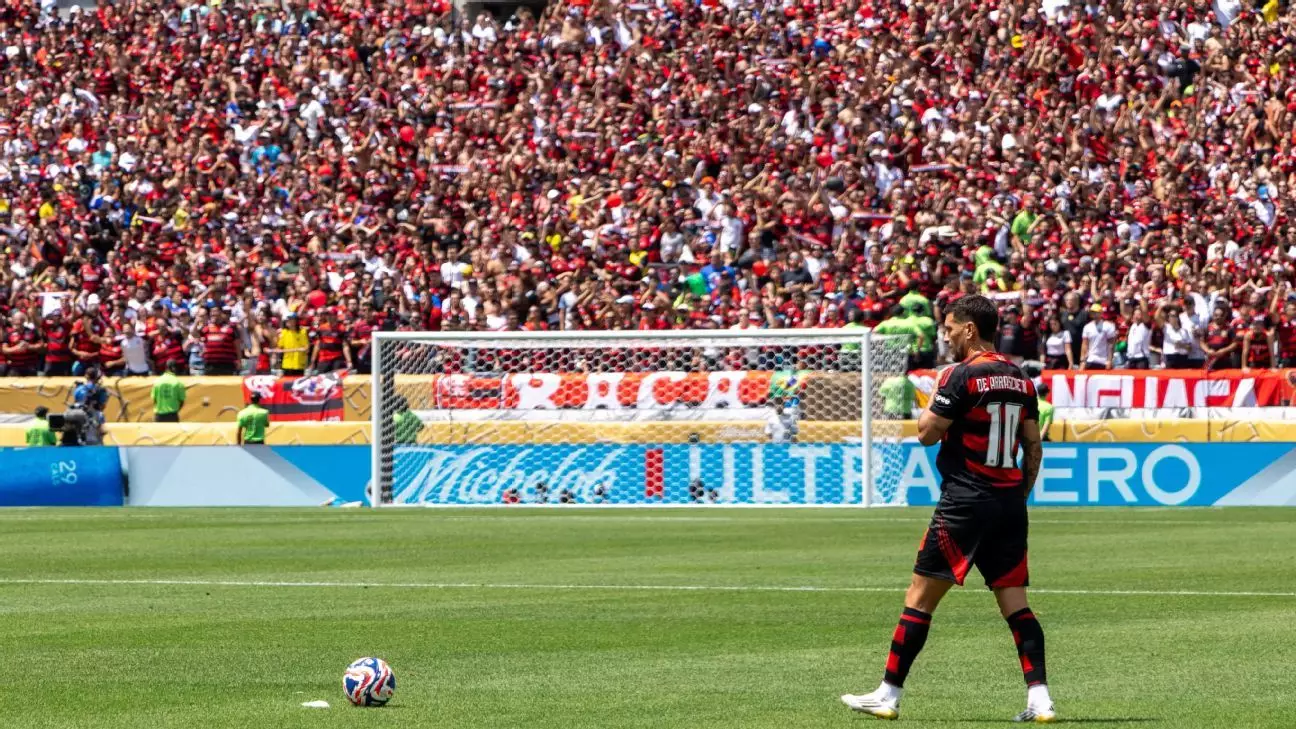As the spotlight shifts to Brazil’s ambition to host the next FIFA Club World Cup, the narrative surrounding the tournament takes a thrilling turn. Since its inception, it seems that not everything has gone smoothly; early reports of lackluster crowds and disruptive weather conditions paint a concerning picture. However, despite these obstacles, South American clubs have transcended expectations, breathing life into an event that some critics are quick to dismiss. With the tournament expanding to 32 teams, Brazil’s heritage as a football powerhouse is magnificently highlighted, indicating not just a fit destination but a potential rebirth for the competition itself.
Through passion, determination, and raw talent, fans from Brazil and Argentina have transformed this world stage into something akin to a home ground. Their vibrant presence sends a thunderous message: this tournament is worth caring about. The South American contingent—comprised of legendary clubs steeped in both history and fervor—has significantly elevated the atmosphere. As they continue to perform in pivotal matches, their success serves as a reminder that the heart of football still beats fervently in South America.
Surpassing Expectations
Few could have predicted the hype surrounding the performance of South American teams in this Club World Cup. Botafogo’s stunning victory over Paris Saint-Germain was a pivotal moment, forcing skeptics to reconsider their outlook. Meanwhile, Fluminense’s ascent has taken many by surprise, demonstrating that the competition’s unpredictability can often lead to exhilarating moments. Clubs like Flamengo and Palmeiras remain steady, executing careers with the urgency of seasoned athletes who understand their window of opportunity. As the tournament progresses, it’s clear that these teams didn’t just come to fill slots—they arrived with a mission to assert their prowess.
These clubs symbolize a rich tapestry woven into the psyche of South American football. The Copa Libertadores, revered as the continent’s premier club competition, has existed since 1960, echoing the aspirations of clubs that seek to rival Europe’s best. The urgency of this quest ripples through every match, lighting a fire in the players and fans alike. With their eyes firmly focused on the Club World Cup prize, the sense of ambition reaffirms the dedication that South American teams bring to international competition.
Dynamic Strategies and Strategic Signings
The tactical advancements present in South American clubs signal a renewed approach towards attaining global accolades. Take Flamengo, for example; the club, with its history of both triumph and tribulation, has cleverly integrated midfielder Jorginho into its ranks—a strategic move that seems to have unified the team’s tempo and enhanced their offensive capabilities. Under the guidance of coach Filipe Luis, Flamengo has balanced ambition with caution, demonstrating the depth of their character by recovering from near-eliminations in past campaigns.
Logically, Palmeiras follows suit with disciplined planning, unafraid to invest lavishly in talent. The acquisition of young striker Vitor Roque from Barcelona speaks volumes about their aspirations while ensuring that existing key players remain intact for this competition. Their coach, Abel Ferreira, embodies a cerebral approach akin to a younger José Mourinho—harmonizing strategy with flair. Despite not being the most visually impressive, Palmeiras has proven to be a well-oiled machine, ready to take on formidable adversaries.
Defensive Masterpieces and Tactical Ingenuity
The modern understanding of Brazilian football extends beyond mere flamboyance; defensive solidity has become an art form. Botafogo’s recent triumph underscores not only their talent but also their aptitude for tactical discipline. Against PSG, they molded an unexpected defensive strategy, illustrating that a well-structured team could absorb pressure while launching successful counter-attacks. Their game plan dismantles stereotypes surrounding South American play—a testament that grit and sense can outweigh sheer flair.
As the tournament progresses, focus shifts to individual matches that could prove pivotal. For Botafogo, the challenge will be navigating the pressures of competing against Atletico Madrid while maintaining focus in the searing heat of Pasadena. Flamengo’s successful bid for advancement invites the question of whether others will join them in the knockout stages. The stakes remain high as each match takes on a defining character, and teams will likely be pushed to their limits, revealing the true resilience of South American clubs.
The clash between expectation and reality has forged a new narrative for the Club World Cup, richly layered with ambition and cultural pride. South American teams have come not just to compete but to etch their names into history, embraced by a fanbase that swells with national pride. As they strive for glory, their spirited performance in the tournament stands testament to the unyielding essence of football itself.

